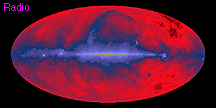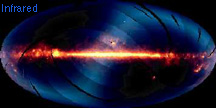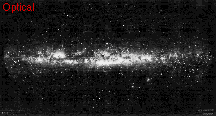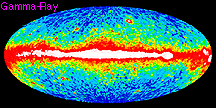Shedding a New Light on the Universe
A Telescope for All Occasions
Looking at our own Galaxy with different telescopes and in different energies, we can see why multiwavelength astronomy is important. Each of the images to the right shows our Milky Way Galaxy, but each gives a different perspective on it.
|
The radio image of our Galaxy, taken at a frequency of 408 MHz, is a mosaic of data taken by the Jodrell Bank, Effelsberg and Parkes radio telescopes. Near this frequency, cosmic radio waves are generated by high energy electrons spiraling along magnetic fields. This false color image shows the Galactic plane running horizontally through the center, however, you will find that no stars are visible. Instead, many of the bright sources near the plane are distant pulsars, star forming regions, and supernova remnants, while the grand looping structures are pieces of bubbles blown by local stellar activity. External galaxies like Centaurus A, located above the plane to the right of center, and the Large Magellanic Cloud (LMC) (below and right) also shine in the radio sky. The infrared image taken by the Infrared Astronomical Satellite (IRAS), shows the center region of our Galaxy. The hazy, horizontal S-shaped feature that crosses the image is faint heat emitted by dust in the plane of the solar system. The optical picture is one we may be most familiar with. It shows something similar to what you would see if you drove out into the country in the summer and looked towards the center of our Galaxy. Large optical telescopes can show us fine detail that our eyes are unable to resolve. The X-ray image is from the ROSAT All-Sky Survey. It shows X-rays at energies of .75 keV. This image is dominated by the radiation from the north polar spur and from the large-scale central region of our Galaxy, which contains hot interstellar matter and tens of thousands of unresolved point sources. Near the equator in the left half of the image, the Cygnus superbubble becomes visible as a broken yellow and red ring. The Vela supernova remnant is an isolated red spot towards the right side of the image. The gamma-ray image includes all photons with energies greater than 100 MeV. At these extreme energies, most of the celestial gamma-rays originate in collisions of cosmic rays with hydrogen nuclei in interstellar clouds. Confused by the different units used for measuring the different energies of light? Click here for a handy chart that explains this!
|

|

|
|

|
|

|
|

|
What specific information do observations in different energies give us? Well, let's examine the Crab Nebula in four different energies of light and see how different the information from each observation is.

Previous |

Next |


